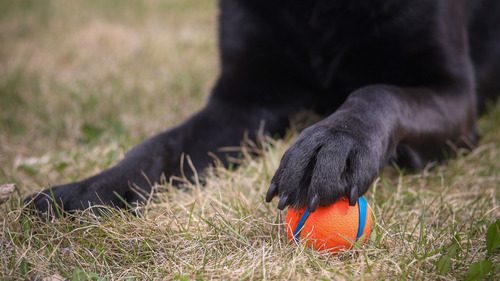Why Do Dogs Wag Their Tails?
Dogs wag their tails to communicate. Tail wagging is a natural behavior that expresses a dog’s emotions, intentions, and reactions to the world around them. From joy and excitement to uncertainty or caution, a wagging tail serves as a window into a dog’s state of mind. For pet owners wondering “Why do dogs wag their tails?”, the answer lies in understanding body language, context, and the subtle signals that tails convey.
At Companion Animal Hospital of Wakefield in Raleigh, NC, we love helping pet owners learn more about canine behavior. The way your dog wags their tail tells a story, and the more you know, the stronger your bond can become. Let’s explore the reasons behind this behavior and how to interpret it more clearly.

The Language of the Tail
When asking, “Why do dogs wag their tails?”, it’s important to recognize that tail movement is a form of communication, not just a reflex. Dogs rely on body language more than words, and their tails act like a signal flag. A tail’s motion, speed, and position all carry meaning. A slow wag can indicate caution or uncertainty, while a fast wag often reflects excitement. The height of the tail is just as important. A tail held high might express confidence or alertness, while a tail carried low may show submission or relaxation. For pet owners in Raleigh, paying attention to these details helps answer the question: why do dogs wag their tails differently depending on the situation?
Tail Position and Emotional Clues
High Tail Carriage
When a dog holds their tail high and wags it stiffly, they may be showing alertness or even dominance. This posture can indicate that the dog is watching their environment closely, ready to react.
Mid-Level Wag
A relaxed, side-to-side wag at mid-level often communicates friendliness or contentment. This is the classic “happy dog” wag many pet owners recognize at the door when they come home.
Low or Tucked Tail
A tail held low or tucked between the legs often reflects fear, insecurity, or submission. In this case, the wag may be minimal or absent, reinforcing that the dog is uncomfortable. By observing both the height and the motion of the tail, you can better understand why your dog is wagging at any given time.
The Role of Speed and Direction
Another layer of understanding the question “Why do dogs wag their tails?” involves speed and direction. The tempo of the wag can reveal the intensity of a dog’s emotions.
- Fast wagging usually reflects high energy, enthusiasm, or excitement.
- Slow wagging may show uncertainty or cautious observation.
- Wagging to the right has been linked in studies to positive feelings, while wagging to the left may signal stress or unease.
These subtle differences remind us that not all wags mean happiness, which is why context matters.
Social Communication Among Dogs
Dogs often wag their tails when interacting with other dogs. In these moments, wagging helps reduce tension, signal friendly intentions, or show boundaries. If you’ve ever seen two dogs meet at the park, their tails likely told much of the story before any bark or growl was heard.
Understanding why dogs wag their tails in social settings can help prevent misunderstandings. A friendly wag may invite play, while a stiff, upright wag could signal caution. As a pet owner, noticing these distinctions helps keep interactions safe and enjoyable.
Tail Wagging and Human Interaction
Dogs also wag their tails to communicate with people. When your dog greets you with a wide, sweeping wag, it usually means excitement and affection. But wagging during training, grooming, or veterinary visits may look different.
For example, a wagging tail paired with a tense body might show nervousness rather than joy. This is why understanding why dogs wag their tails requires reading the entire body, not just the tail itself. At Companion Animal Hospital of Wakefield, we often observe tail movements during exams to gauge comfort levels. This helps us adjust our approach to keep pets at ease.
Puppy Tail Wagging
Puppies wag their tails for slightly different reasons than adult dogs. Very young puppies may not wag at all until they are a few weeks old, when they begin learning social communication. By the time they interact with littermates and people, tail wagging becomes part of their developing language. For puppy owners in Raleigh, it’s rewarding to watch tail movements evolve from clumsy wiggles to expressive communication. Observing these changes helps answer the question, “Why do dogs wag their tails at different life stages?”
Misconceptions About Tail Wagging
Many people believe tail wagging always means a dog is happy. While this is true in some cases, it’s not universal. Tail wagging can also reflect stress, fear, or aggression. For example, a dog may wag when meeting a stranger but still feel uncomfortable. Likewise, wagging in combination with growling or baring teeth signals tension, not friendliness. Recognizing these nuances clarifies why dogs wag their tails and prevents misinterpretation.
Tail Types and Breed Differences
Different breeds have different tail shapes, and these affect how wags look.
Curly Tails
Breeds like Pugs or Shiba Inus carry tails curled tightly over their backs, making subtle wags harder to see. Owners often rely on overall body language to interpret emotions.
Long Tails
Breeds with long, flowing tails, such as Golden Retrievers, display wags more clearly, making communication easier to read.
Docked Tails
Some breeds have docked tails, limiting their ability to signal with wagging. These dogs rely more heavily on ear position, posture, and facial expression. Understanding why dogs wag their tails means taking breed characteristics into account, since not all dogs express themselves in the same way.
Beyond Communication: The Evolution of Tail Wagging
The history of tail wagging ties back to canine evolution. Wolves, the ancestors of domestic dogs, use tails to communicate within their packs. Modern dogs inherited this trait, expanding its use to interact with both humans and other animals.
From a survival perspective, tails became an essential tool for reducing conflict and coordinating social behavior. By studying this evolution, we better understand why dogs wag their tails today and how it connects to centuries of canine communication.
Observing Your Dog’s Tail in Daily Life
For pet owners in Raleigh, watching your dog’s tail is a simple way to learn more about their feelings. Whether during playtime, a walk through your neighborhood, or a visit to Companion Animal Hospital of Wakefield, every wag is meaningful. Ask yourself: Is the wag fast or slow? Is the tail high, mid-level, or low? Is the dog’s body relaxed or tense? These observations provide valuable insight into why dogs wag their tails in different situations.
Strengthening the Bond Through Understanding
So, why do dogs wag their tails? Because it’s their way of talking to us and to each other. By paying attention to wagging patterns, speed, and position, pet owners gain a deeper understanding of their dog’s emotions. This awareness enhances trust, improves communication, and strengthens the human-animal bond.
At Companion Animal Hospital of Wakefield, we encourage pet owners to learn more about canine behavior and use that knowledge to support happy, healthy relationships. If you’d like to discuss your dog’s behavior further, call us at (919) 488-5300 today.
Recent Posts

Everything You Need to Know about Hepatitis in Dogs

Reasons Your Cat is Losing Weight

My Dog’s Eye is Cloudy: Should I Be Worried?
About Us
At Companion Animal Hospital of Wakefield, our veterinarians in Raleigh, NC, provide better care for your pets. As members of your family, cats and dogs deserve the highest level of medicine with the most compassion. That’s why we put a strong emphasis on personalized care for your pet and client education for you. We believe that when we take the time to help you thoroughly understand your pet’s health, we’re able to make the best decisions for their care together.


